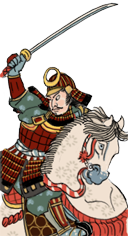
Katana Cavalry
These heavy cavalry are shock troops intended to charge home and cut down enemies with their katana swords.Cavalry warfare is traditionally the preserve of the samurai. Only they have the skill to wield a sword while steering a horse into battle. Katana cavalry are extremely well trained and the weight of their steeds adds to the power of their charge. After a charge, they remain mounted and can engage the enemy with their katana keeping a height advantage over foot soldiers. However, they are vulnerable when facing spears, whether as a wall of spears or a lone, brave enemy thrusting at the belly of a horse.
The Sengoku Jidai saw Japanese warfare shift from the ritualistic, single combat fought by honour-hungry samurai to the kind of indiscriminate, larger battles that were taking place in medieval Europe. Less skilled troops such as the ashigaru were introduced and then armed with matchlocks, but mounted warfare was still for samurai alone. Bows, spears and katana were all used from horseback and, if a samurai was wealthy enough, he would have an assistant to carry and hand him his weapons as needed. The katana, although traditionally used with two-hands, could still be effective when used in a one-handed grip by a horseman. Swung downwards onto an enemy foot soldier, the sharp, curved blade could easily cut through a man.
Unit Name Katana Cavalry |
Unit Key Cav_Sword_Katana_Cavalry |
Soldiers 80 |
Category Cavalry |
Class Sword Cavalry |
Multiplayer Cost 800 |
└ Multiplayer Limit 0 |
Recruitment Cost 950 |
├ Recruitment Turns 2 |
└ Unit Limit 0 |
Upkeep Cost 200 |
Melee Attack 18 |
└ Melee Weapon sabre |
Charge Bonus 15 |
Bonus vs Cavalry 0 |
Melee Defence 6 |
Armour 7 |
Horse Mode shogun_horse_samurai |
└ Mount Armour 6 |
Morale 12 |
Abilities
-
 Wedge Formation
Wedge Formation
Trained to charge in a wedge formation in order to better penetrate enemy formations
Strengths & Weaknesses
- Very good in melee.
- Slower than other cavalry.
- Vulnerable against yari and naginata infantry.
- Vulnerable to matchlocks.
|
|
|
|
|
|


 Français
Français Italiano
Italiano Deutsch
Deutsch Español
Español Русский
Русский Čeština
Čeština Polski
Polski Türkçe
Türkçe 简体中文
简体中文 正體中文
正體中文 日本語
日本語